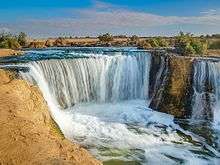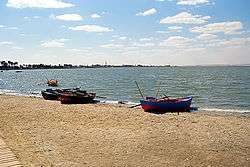Wadi El Rayan
Wadi El Rayan is a unique nature protectorate in Faiyum Governorate, Egypt, under the supervision of the Ministry of Environmental Affairs (EEAA).
| Wadi El Rayan | |
|---|---|
.jpg) Wadi El Rayan lake | |
| Location | Faiyum Governorate, Egypt |
| Coordinates | 29°08′52″N 30°23′33″E |
| Area | 175,790 hectares (434,400 acres) |
| Official name | Wadi El Rayan Protected Area |
| Designated | 4 June 2012 |
| Reference no. | 2041[1] |
Geography

The valley of Wadi El-Rayan is an area of 1759 km2, 113 km2 of which are the dominating water body of the Wadi El Rayan lakes. It is located about 65 km southwest of Faiyum city and 80 km west of the Nile River. The Wadi has been used for man-made lakes from agricultural drainage which has made a reserve of the two separate Wadi El Rayan Lakes. The reserve is composed of a 50.90 km2 upper lake and a 62.00 km2 lower lake, with waterfalls between the two. Among the springs, there are three sulphur springs at the southern side of the lower lake, with extensive mobile sand dunes. Wadi El Rayan Waterfalls are considered to be the largest waterfalls in Egypt.
At the south and southeast of the springs is Gabal Manqueer Al Rayan, where marine fossils and archeological remains are found. Gabal Madwera, near the lower lake, is known for its extensive dune formations.
In the northwest is Wadi El Hitan, a protectorate containing fossils of extinct whales.[2]
Flora and fauna
The vegetation is confined to inter-dune areas around springs and at the base of large dunes. The vegetation cover is made of 13 species of perennial plants and a few individuals of Calligonum comosum and Zygophyllum album.
Wadi El Rayan accommodates one of the world's few remaining populations of the endangered slender-horned gazelle. The dorcas gazelle is still found in the area in small numbers, while both the fennec fox and Rüppell's fox are scarce. There are 11 species of reptiles, 9 species of mammals, 13 species of resident birds, and 26 species of migrant and vagrant birds.
 Qarun Lake
Qarun Lake Qarun Lake
Qarun Lake- Qarun Lake

 Qarun Lake
Qarun Lake Waterfalls
Waterfalls Qarun Lake
Qarun Lake
See also
- Bahr Yussef
- Crocodilopolis
- Faiyum
- Fayum alphabet
- Faiyum Governorate
- Faiyum mummy portraits
- Lake Moeris
- Roman Egypt
References
- "Wadi El Rayan Protected Area". Ramsar Sites Information Service. Retrieved 25 April 2018.
- "12 - Wadi El-Rayan Protected Area in Fayoum Governorate". Ministry of Environment Environmental Affairs Protectorate. Ministry of Environment Egypt. Retrieved 23 May 2018.
External links
| Wikimedia Commons has media related to Wadi el-Raiyan. |